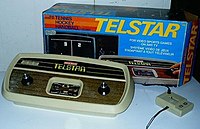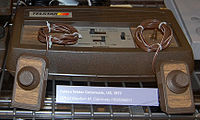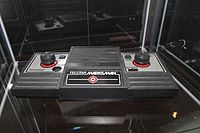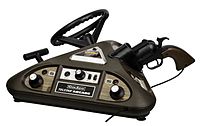
Combat is a video game by Atari, Inc. for the Atari VCS. It was released as one of the nine launch titles for the system in September 1977, and was included in the box with the system from its introduction until 1982. Combat was based on two earlier black-and-white coin-operated arcade games produced by Atari: Tank in 1974 and Jet Fighter in 1975.
Smurf: Rescue in Gargamel's Castle is a 1982 video game published and developed by Coleco for the ColecoVision and Atari 2600. The game is based on the television series The Smurfs. In the game, the player must brave a series of obstacles to rescue Smurfette from Gargamel's castle.

The Telstar Marksman is a first-generation video game console that featured a light gun. It was released by Coleco in 1978. Because it had a manufacturer-set number of games, it is considered a dedicated console. It was part of a series of Coleco Telstar Pong-based consoles; it is essentially a Telstar Colortron bundled with a "3 in 1" light gun and two shooting games. The Marksman light gun is a pistol that features an attachable stock and barrel. It is similar in this regard to the later-released Stack Light Rifle and the Sega Menacer. The elongated barrel included a simple aiming sight. In addition to the light gun, the system featured two paddle controllers built directly into the console. Its reported features included "on-screen digital scoring" and three different difficulty settings. It required two nine-volt batteries or Coleco's Perma Power AC adaptor to power the system.

The APF TV Fun home video game consoles are a series of dedicated consoles manufactured by APF Electronics Inc. and built in Japan starting in 1976. The systems were among the first built on the General Instrument 'Pong on a chip', the AY-3-8500, that allowed many manufacturers to compete against the Atari home pong. The APF TV Fun consoles were one of the eraliest pong clone consoles.
In the history of video games, the second-generation era refers to computer and video games, video game consoles, and handheld video game consoles available from 1976 to 1992. Notable platforms of the second generation include the Fairchild Channel F, Atari 2600, Intellivision, Odyssey², and ColecoVision. This generation began in November 1976 with the release of the Fairchild Channel F; followed by the Atari 2600 in 1977; Magnavox Odyssey² in 1978; Intellivision in 1980; and then the Emerson Arcadia 2001, ColecoVision, Atari 5200, and Vectrex. But, by the end of the era, there were over 15 different consoles. It coincided with, and was partly fueled by, the golden age of arcade video games, a peak era of popularity and innovation for the medium. Many games for second generation home consoles were ports of arcade games. The Atari 2600 was the first to port a game in 1980, with Space Invaders, and ColecoVision bundled in Nintendo's Donkey Kong for the system when it was released in August 1982.
In the history of video games, the first-generation era refers to the computer and video games, video game consoles, and video game handhelds available from 1972 to 1983. Notable consoles of the first generation included the Magnavox Odyssey series released from 1972 to 1978, the Atari Home Pong released in 1975, the Coleco Telstar series released from 1976 to 1978 and the Color TV-Game series released from 1977 to 1980. The generation ended with the Computer TV-Game in 1980 but many manufactures had left the market prior to this due to the video game crash of 1977 and the start of the second generation.
Basic Math is an educational cartridge for the Video Computer System developed by Gary Palmer of Atari, Inc.. The game was one of the nine launch titles offered when the Atari 2600 went on sale in September 1977.

Blackjack is a video game programmed by Bob Whitehead and published by Atari, Inc. for its Video Computer System. The game was one of the nine launch titles available when the Atari 2600 went on sale in September 1977. The game is a video simulation of blackjack. The objective is identical to the card game: to beat the dealer's card total, without going over 21, to win a bet. One to three players play the computer dealer.

Star Ship is a first-person space combat simulator video game programmed by Bob Whitehead and published by Atari, Inc. for its Video Computer System. The game was one of the nine launch titles offered when the Atari VCS was released on September 11, 1977. Based on the Atari arcade game Starship 1, it was the first space-related game developed for the Atari VCS. The re-branded Sears TeleGames version is titled Outer Space.

Video Olympics is a video game programmed by Atari, Inc.'s Joe Decuir for the Atari 2600. It is one of the nine original launch titles for that system when it was released in September 1977. The cartridge is a collection of games from Atari's popular arcade Pong series. A similar collection in arcade machine form called Tournament Table was published by Atari in 1978.
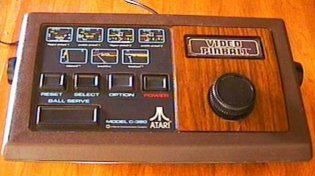
Video Pinball is a Single-player dedicated video game console released in 1977 as an Atari, Inc. Bumper controllers on the sides or a dial on the front are used to control the games depending on the game selected. There are three game types: Pinball, Basketball, and Breakout.

The Atari Video Music is the earliest commercial electronic music visualizer released. It was manufactured by Atari, Inc., and released in 1977 for $169.95. The system creates an animated visual display that responds to musical input from a Hi-Fi stereo system for the visual entertainment of consumers.
Stunt Cycle is a 1 player arcade game by Atari Inc., originally released in 1976. The game is housed in a custom cabinet that includes a simulated motorcycle steering column mounted on the control panel. The monitor is a 19-inch black and white CRT monitor with a black and white overlay.

Cosmic Avenger is a horizontally scrolling shooter developed and published by Universal Entertainment Corporation and released in arcades in 1981. Like Universal's Lady Bug, Cosmic Avenger was not a hit in arcades, but found success and a larger audience as a launch title for the ColecoVision console. It was not ported to other systems. Wes Hupp holds the official record for this game with 117,290 points on November 17, 1982.
The VideoBrain Family Computer is an 8-bit home computer manufactured by Umtech Incorporated, starting in 1977. It is based on the Fairchild Semiconductor F8 CPU. It was not a large commercial success and was discontinued from the market less than three years after its initial release.

The Magnavox Odyssey is a general brand name of the company's complete line of home video game consoles released from 1972 through 1978. The line includes the original Magnavox Odyssey console, both Magnavox and Philips versions of the Odyssey series of dedicated video game consoles, and the Magnavox Odyssey² cartridge-based video game console released in 1978.

Surround is a video game programmed by Alan Miller and published by Atari, Inc. for the Atari Video Computer System. It was one of the nine Atari VCS launch titles released in September 1977. Surround is an unofficial port of the arcade game Blockade, released the previous year by Gremlin. As such, it is the first home console version of the game that would become widely known across many platforms as Snake. As with other early Atari games, it was licensed to Sears, which released it under the name Chase.

The Fairchild Channel F is a game console released by Fairchild Semiconductor in November 1976. It has the distinction of being the first programmable ROM cartridge–based video game console, and the first console to use a microprocessor. It was launched as the Video Entertainment System, or VES, but when Atari released their VCS the next year, Fairchild renamed its machine.

Video is a discontinued American consumer electronics magazine that was published from 1977 to 1999 by Reese Communications with a focus on video and audio devices. The magazine showcases new audiovisual products, analyzes current practices and trends in the field, and provides critical reviews of newly marketed products and equipment. During its early years, it competed fiercely with contemporary journals like Video Review and Video Buyer's Review—ultimately culminating in a 1980 trademark infringement suit over use of the term "Video Buyer's Guide". In March 1995, Video was acquired from Reese by Hachette Filipacchi, and in 1999 it was merged with their bi-monthly Sound & Image magazine to become Sound & Vision.


